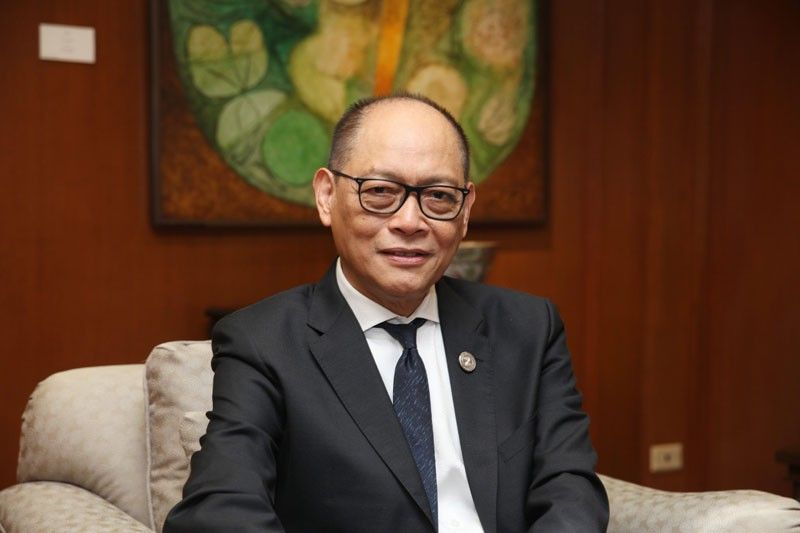BSP chief looks forward to even better 2020

MANILA, Philippines — Last year was bittersweet for the Bangko Sentral ng Pilipinas (BSP) after losing the captain of its ship, Nestor Espenilla Jr., in February to tongue cancer at the age of 60, barely nine months into his six-year term as the head of the country’s central bank.
Former budget secretary Benjamin Diokno was named as the new central bank governor, continuing the battle against high inflation and pursuing reforms in the country’s banking sector.
Diokno, armed with a doctorate degree in economics, is optimistic the Philippines could fare better in 2020 after a temporary setback last year, prompted by the delayed implementation of the 2019 national budget.
Due to the budget impasse as well as the tightening cycle by the BSP in 2018 and the US-China trade war, the country’s gross domestic product (GDP) growth averaged 5.8 percent from January to September last year, lower than the revised six to 6.5 percent target set by economic managers.
Diokno points out the Philippines has one of the fastest growing and most resilient economy in the world.
According to the BSP chief, the country’s GDP is likely to expand between 6.4 and 6.5 percent in the fourth quarter of the year, bringing the full-year growth to six percent this year from 6.2 percent in 2018 amidst a synchronized global slowdown.
“The Philippines is in a very nice place right now,” Diokno assures.
Better 2020
The Development Budget Coordination Committee (DBCC) expects the country’s economy to expand between 6.5 and 7.5 percent in 2020.
“I am very optimistic that 2020 will be even better,” Diokno says.
Inflation averaged 2.5 percent from January to November despite picking up to hit a three-month high of 1.3 percent in November, bottoming out to hit a 43-month low of 0.8 percent in October.
This allowed the central bank’s Monetary Board to slash interest rates by 75 basis points, partially unwinding a tightening cycle that saw benchmark rates jump by 175 basis points in 2018.
Inflation accelerated to 5.2 percent in 2018 from 2.9 percent in 2017 and exceeded the BSP’s two to four percent target, due to elevated oil and rice prices as well as weak peso. It peaked at 6.7 percent in September and October 2018.
Based on its latest assessment, Diokno said the BSP’s Monetary Board would average 2.4 percent in 2019 before picking up to 2.9 percent in 2020 and 2021.
The BSP chief has said upside risks to inflation over the near term emanate mainly from potential volatility in international oil prices amid geopolitical tensions in the Middle East as well as from the potential impact of the African Swine Fever outbreak and recent weather disturbances on domestic food prices.
On the other hand, uncertainty over trade policies in major economies would continue to weigh on global economic activity and demand, and could thus mitigate upward pressures on commodity prices.
Aside from the reduction of interest rates, the central bank also lowered the level of deposits banks are required to keep with the central bank by 400 basis points for big and mid-sized banks, and by 200 basis points for small banks to free up additional funds into the financial system to boost economic activity.
The late BSP governor had committed to bring down the ultra high reserve requirement ratio to single digit by 2023. The level has been reduced by 600 basis points since 2018.
BSP signals 50 bps cut, slower RRR reduction
Diokno has hinted the BSP could reduce interest rates further by 50 basis points in 2020 as central banks around the world continued to pursue monetary easing.
However, the central bank intends to resume the reduction of the RRR level albeit rather at a slower pace.
Authorities, Diokno say only need to lower the RRR by 500 basis points over four years to bring it down to a single digit level of nine percent.
“We are happy where we are. We are looking at a slower pace for RRR cuts but we are looking at reducing interest rates by at least 50 basis points. Whether that will come in the first quarter or second quarter, we will see. That is better than being deliberately vague,” the BSP chief added.
Between P90 billion to P100 billion worth of liquidity are released into the financial system for every percentage point reduction in the level of deposits banks are required to keep with the central bank.
“At the moment we are very comfortable where we are. The economy is doing well, inflation is low, unemployment is low, the gross international reserves is at all-time high, and the exchange rate is stable,” Diokno said.
Maysita Crystallin, economist at DBS Bank Ltd. of Singapore, predicts the BSP is likely to slash interest rates only by 25 basis points in the first quarter as inflation would pick up to 3.5 percent next year from about 2.8 percent this year due to the low base effect as well as higher economic activity.
“Yet, we think it is unlikely for inflation to exceed the BSP’s upper limit of four percent, providing BSP with room for another 25 basis points cut, most likely in 1Q 2020, before inflation starts picking up,” Crystallin said.
The Singaporean bank sees the GDP growth of the Philippines accelerating to 6.3 percent in 2020 and 2021 after weakening further to 5.9 percent in 2019 from 6.2 percent in 2018.
Euben Paracuelles, ASEAN economists at Nomura Securities Ltd., for his part, says, the central bank’s Monetary Board is likely to keep interest rates untouched in 2020 as inflation is likely to rise to 3.1 percent in 2020 and 3.3 percent, but expects a 200 basis points reduction in the RRR.
“We, therefore, continue to forecast BSP will keep its policy rate unchanged at four percent throughout 2020, after delivering a total of 75 basis points in 2019.
Nomura sees the country’s GDP growth accelerating to 6.7 percent in 2020 and 6.8 percent in 2021 from about six percent in 2019.
“In our view, 2020 presents a more conducive environment than in 2019 for the economy to thrive, despite the likely persistence of external uncertainty. The mid-term elections, as expected, proved an interruption to the passing of the next phase of the fiscal reforms, but the administration gained more support in both houses of Congress,” Paracuelles said.
Road to “A”
Monetary and fiscal authorities are working doubly hard to pursue reforms to push the Philippines to its next stage of development.
Diokno said the country continues to enjoy investment grade credit ratings from S&P Global Ratings, Moody’s Investors Service, and Fitch Ratings, and is on the cusp of becoming an upper middle income economy.
“With the reform momentum, we expect the Philippines to become an A-rated economy in the next two years or so, and to become a high income economy by 2040,” the BSP chief said.
S&P Global Ratings upgraded the country’s credit rating to BBB+, or just a notch below the much coveted A rating, last April on the back of the country’s above-average economic growth, healthy external position, and sustainable public finance despite global economic challenges.
Both Moody’s Investor Service and Fitch Ratings retained the country’s credit rating at Baa2 and BBB, respectively, or one notch above minimum investment grade.
Diokno cites that both unemployment and poverty levels are at historic lows.
“Unemployment is at its historic low. I have not seen this kind of unemployment numbers in my life at 4.5 percent and then even underemployment is much, much better. It used to be double digit in the upper 20s now it is really down,” Diokno said.
Latest data from the Philippine Statistics Authority (PSA) showed the poverty incidence rate in the country dropped to 16.6 percent in 2018 from about 23 percent in 2015.
“To me that is roughly two percent every year, that is unprecedented, that kind of reduction. So we are very optimistic that maybe before the end of this administration’s term, poverty incidence will be in the neighborhood of 10 percent,” Diokno said.
PHL banks remain sound and stable
The BSP chief insists the country’s banking system remains sound and stable.
“With healthy indicators, including more-than-adequate capitalization and low exposure to bad debts, banks are able to help fund the growing investment requirements in the economy,” Diokno said.
Data showed assets of Philippine banks increased by 6.6 percent to P17.86 trillion as of end-October this year from P16.76 trillion as of end October last year.
Additionally, earnings of the country’s banking industry surged 30 percent to P171.16 billion in end September this year from P131,53 billion in end September last year.
Bank lending went up by 8.8 percent to P8.71 trillion in end October this year from P8 trillion in end October last year.
“This bodes well for sustained growth. Robust lending growth has consistently come along maintenance of good quality of loans, reflecting observance of prudent lending standards,” the pro growth BSP governor added.
Bring BSP closer to the people
Diokno remains steadfast in bringing the BSP closer to Filipinos who are its ultimate stakeholders.
“The BSP’s public communication will underscore that its promotion of price stability, financial stability, and an effective payments system is aimed at enhancing the economic and financial well being of Filipinos,” he concluded.
- Latest
- Trending























